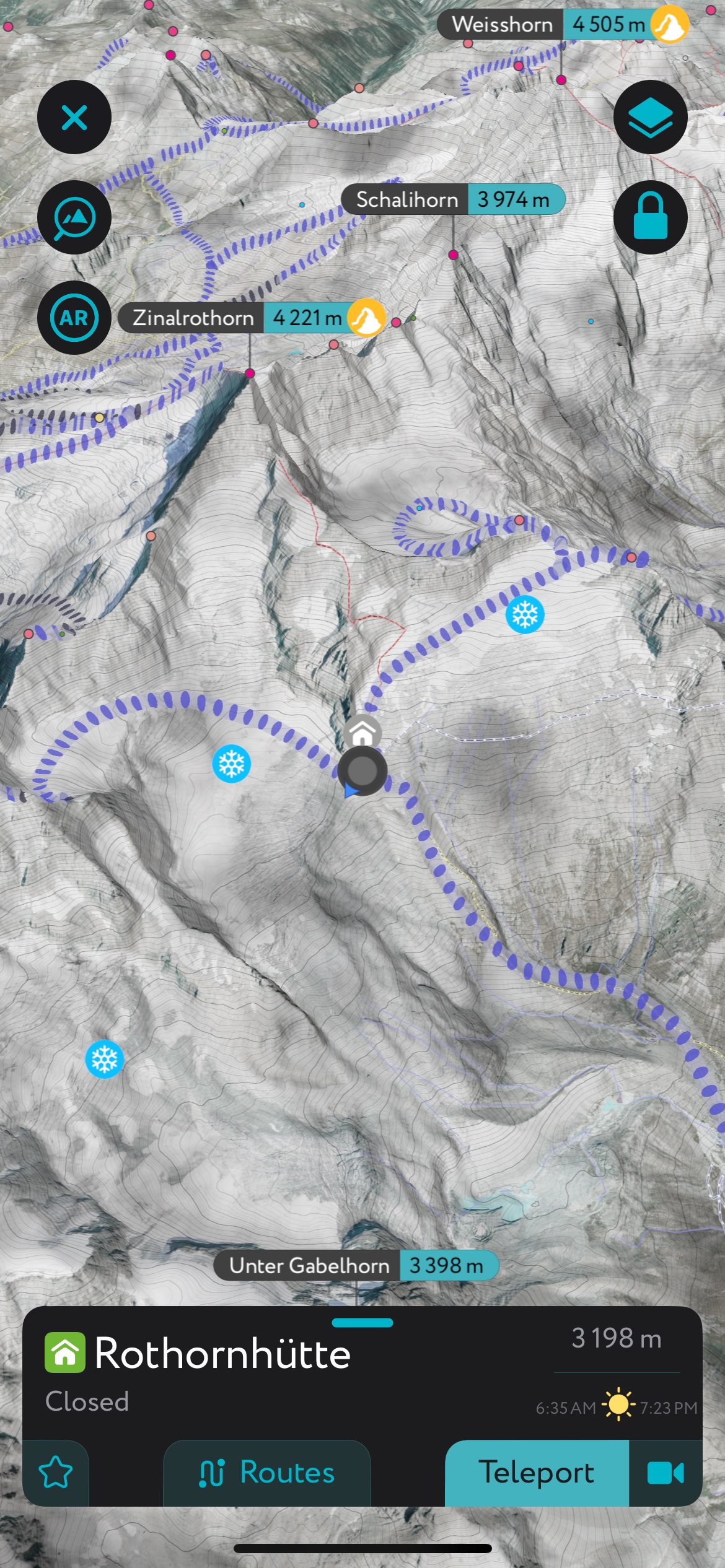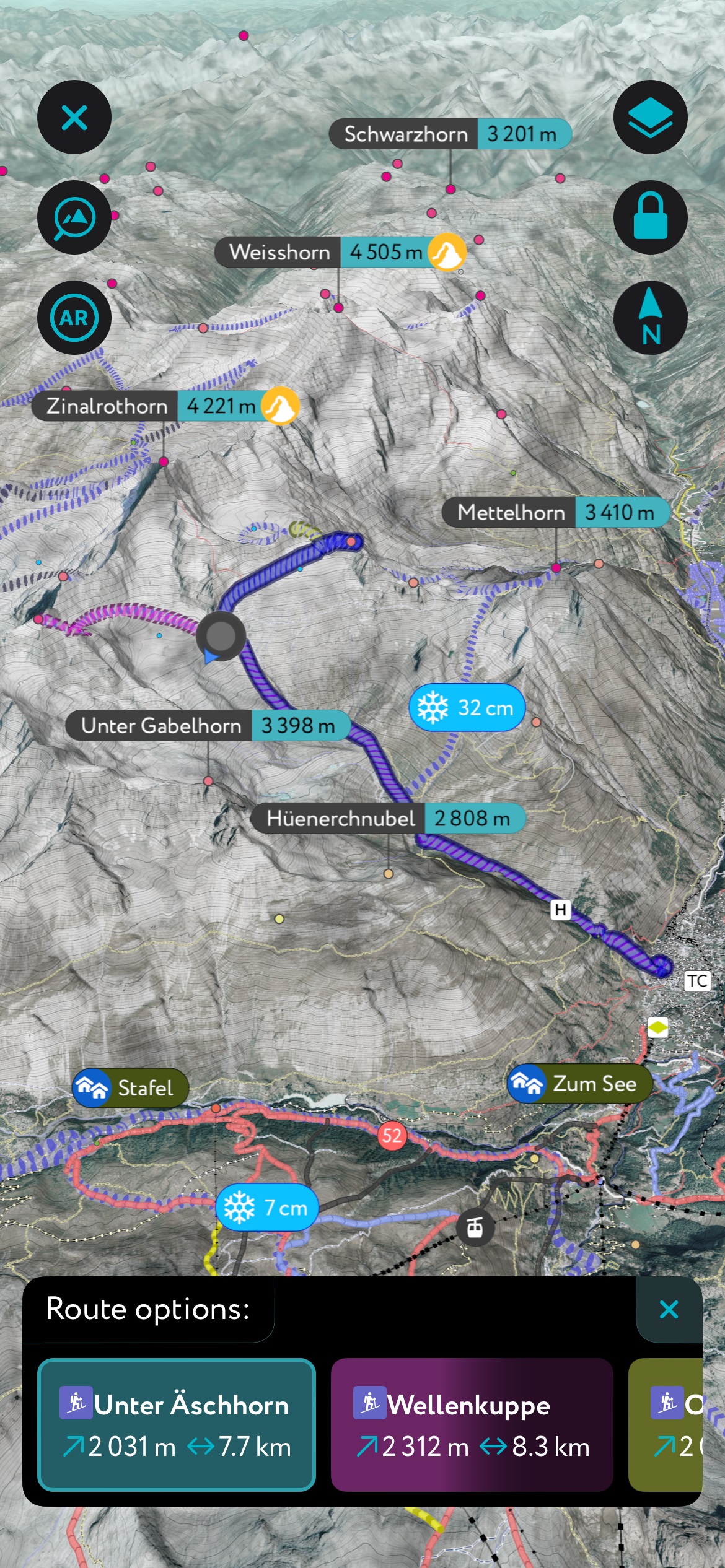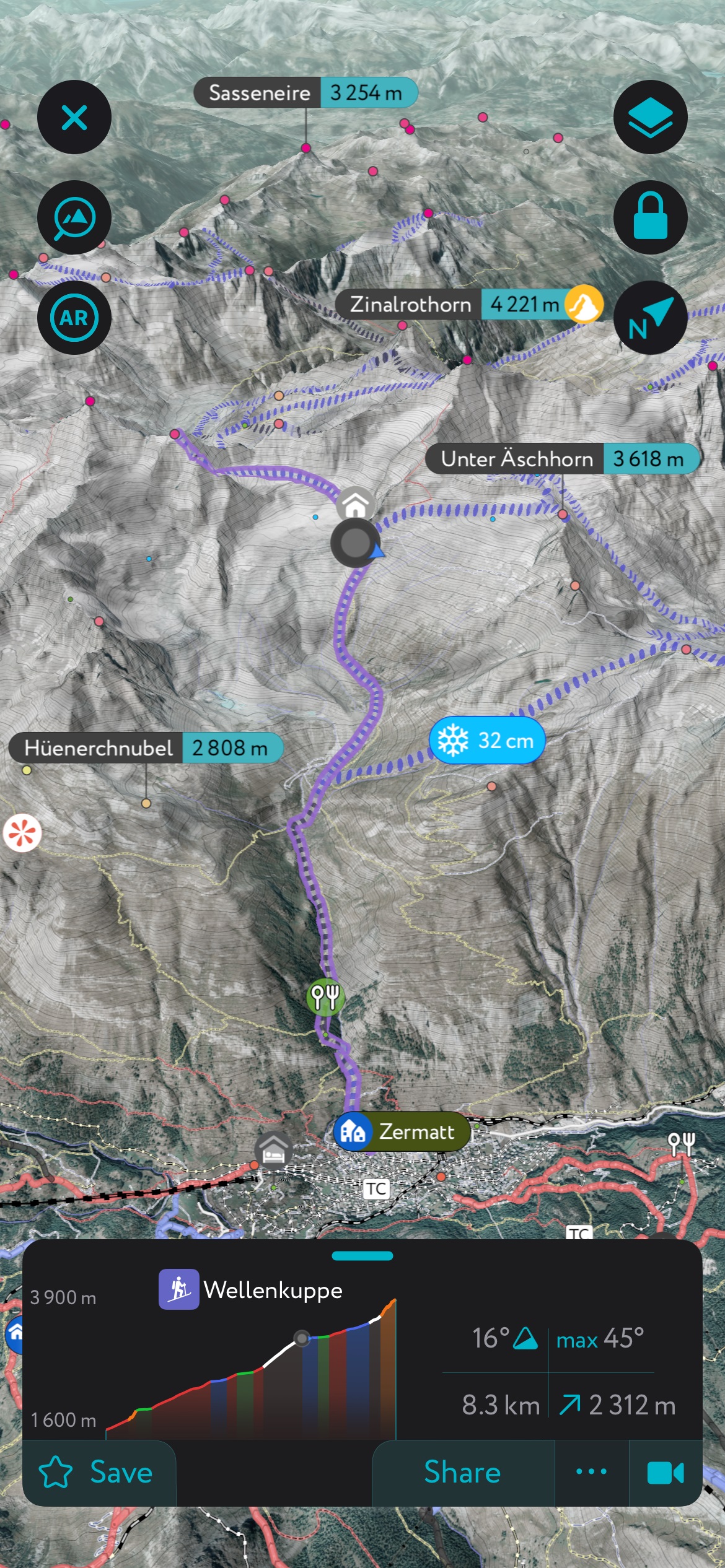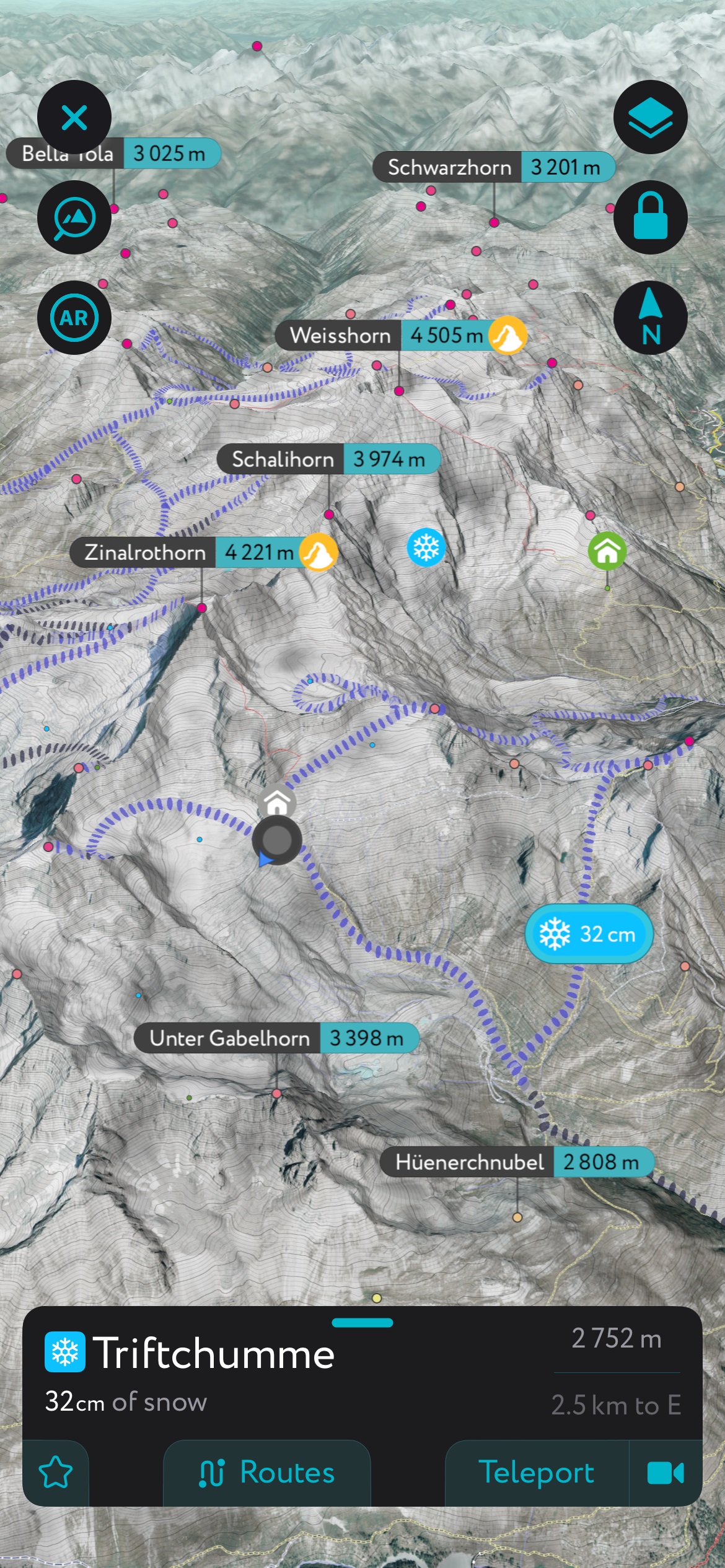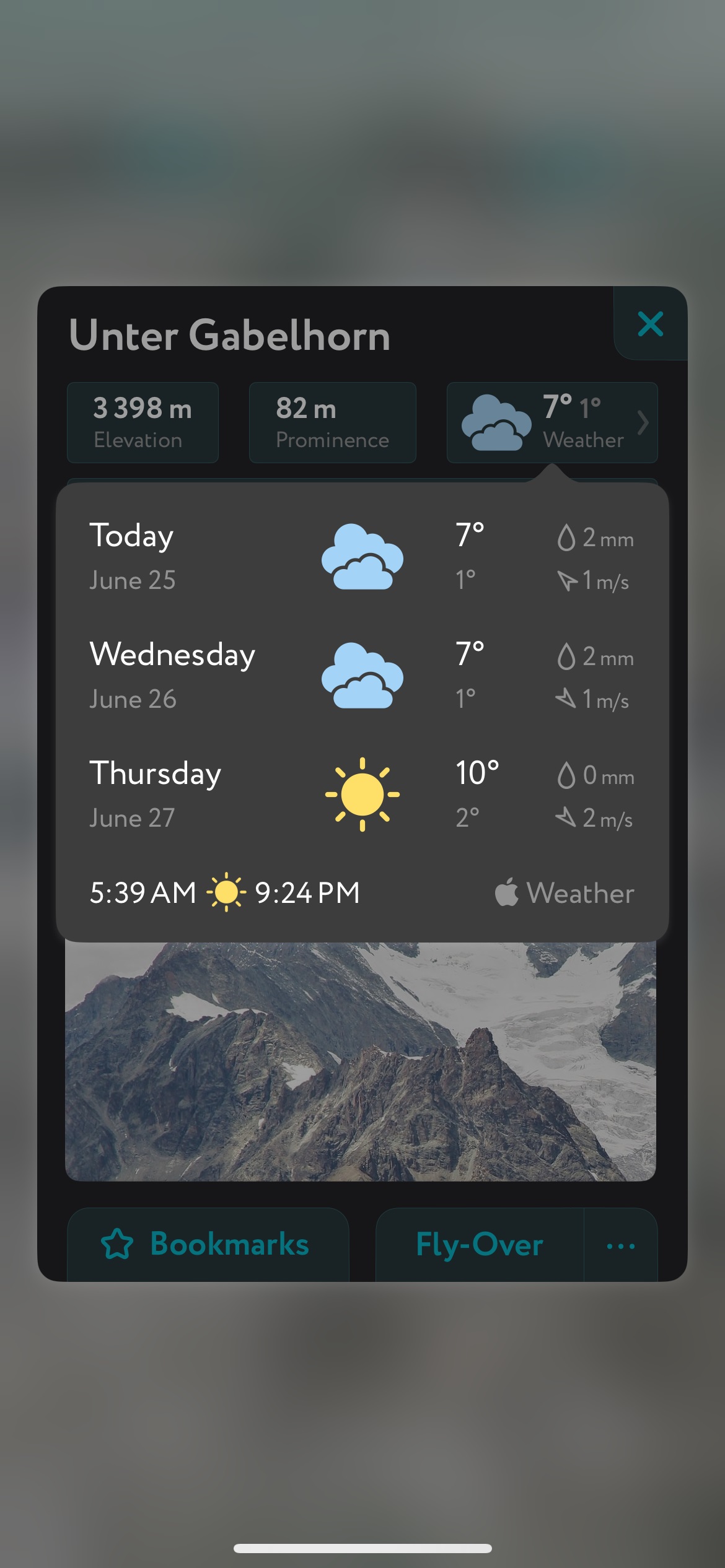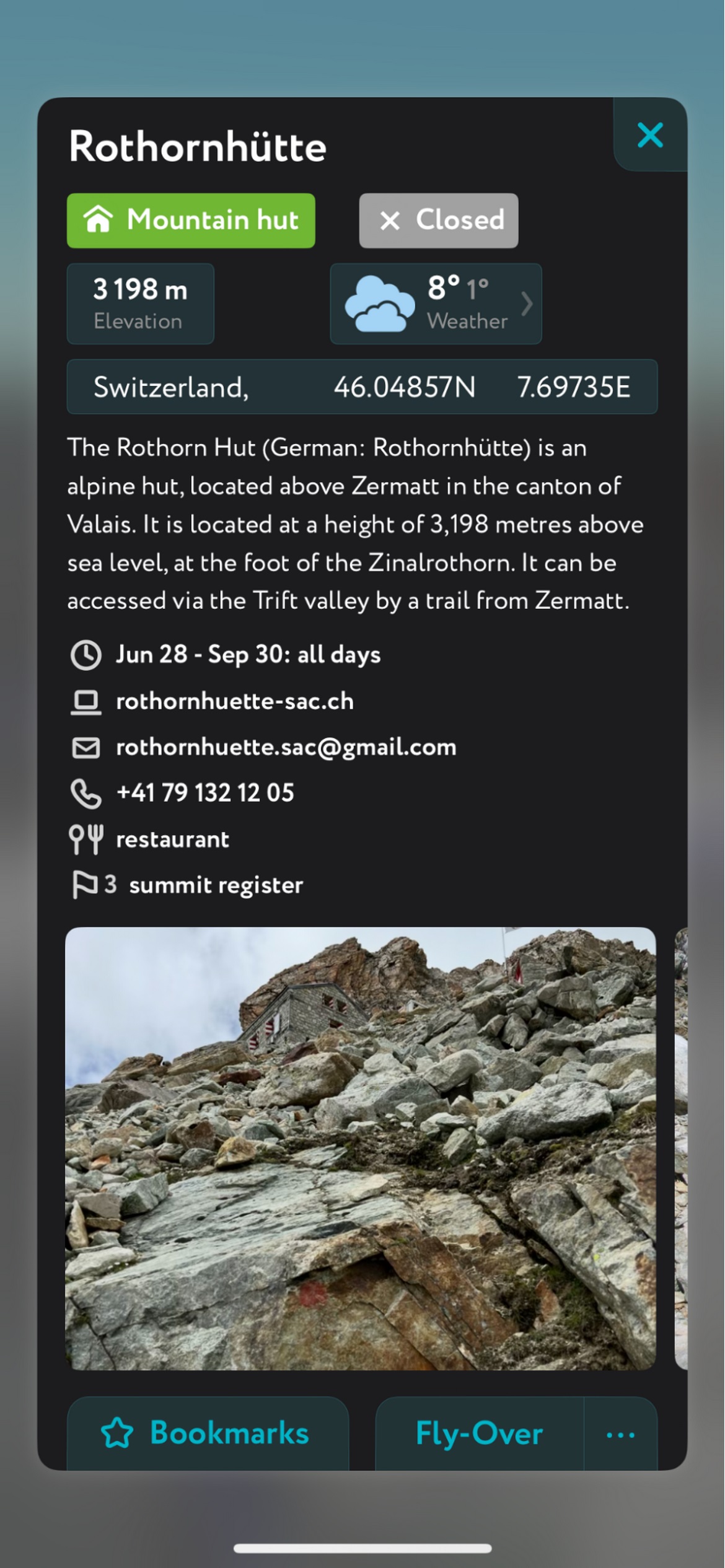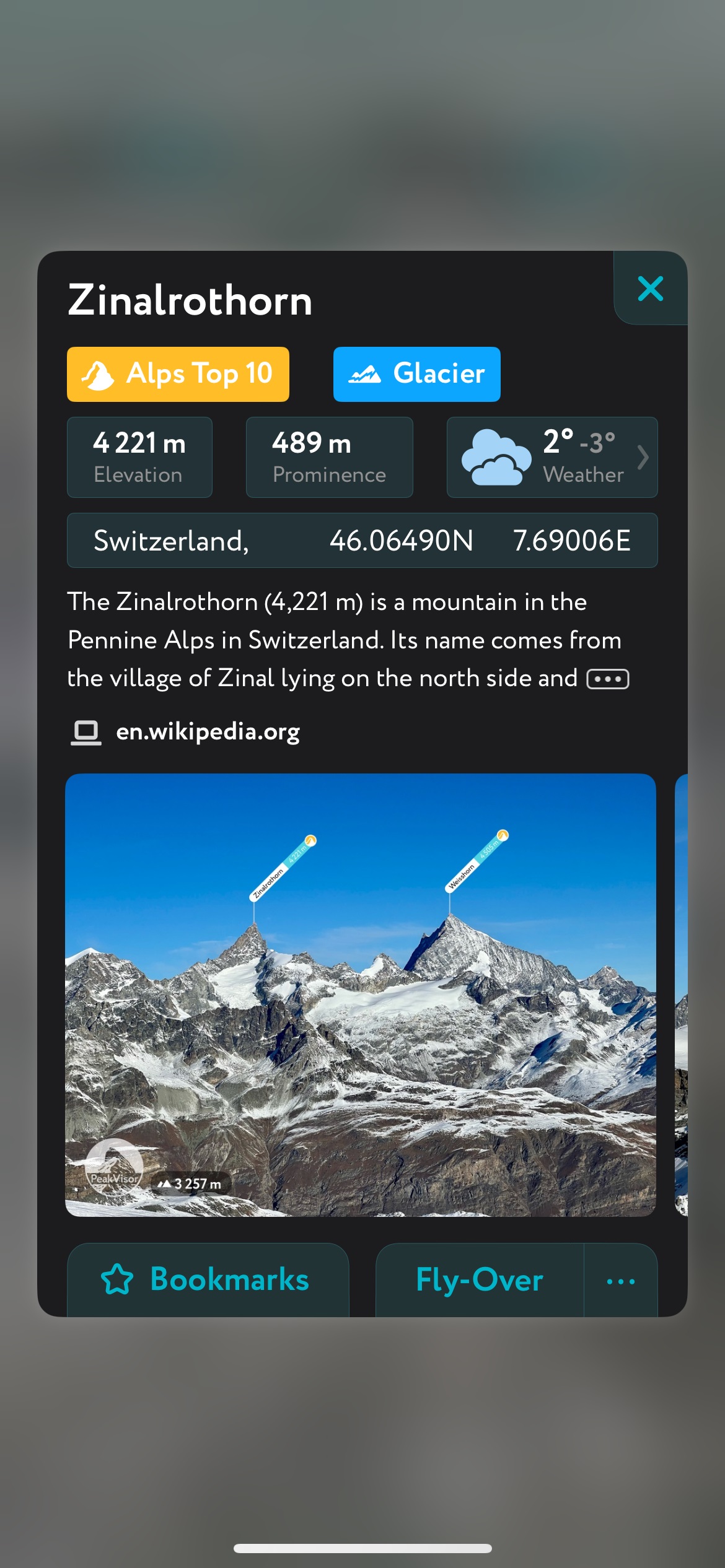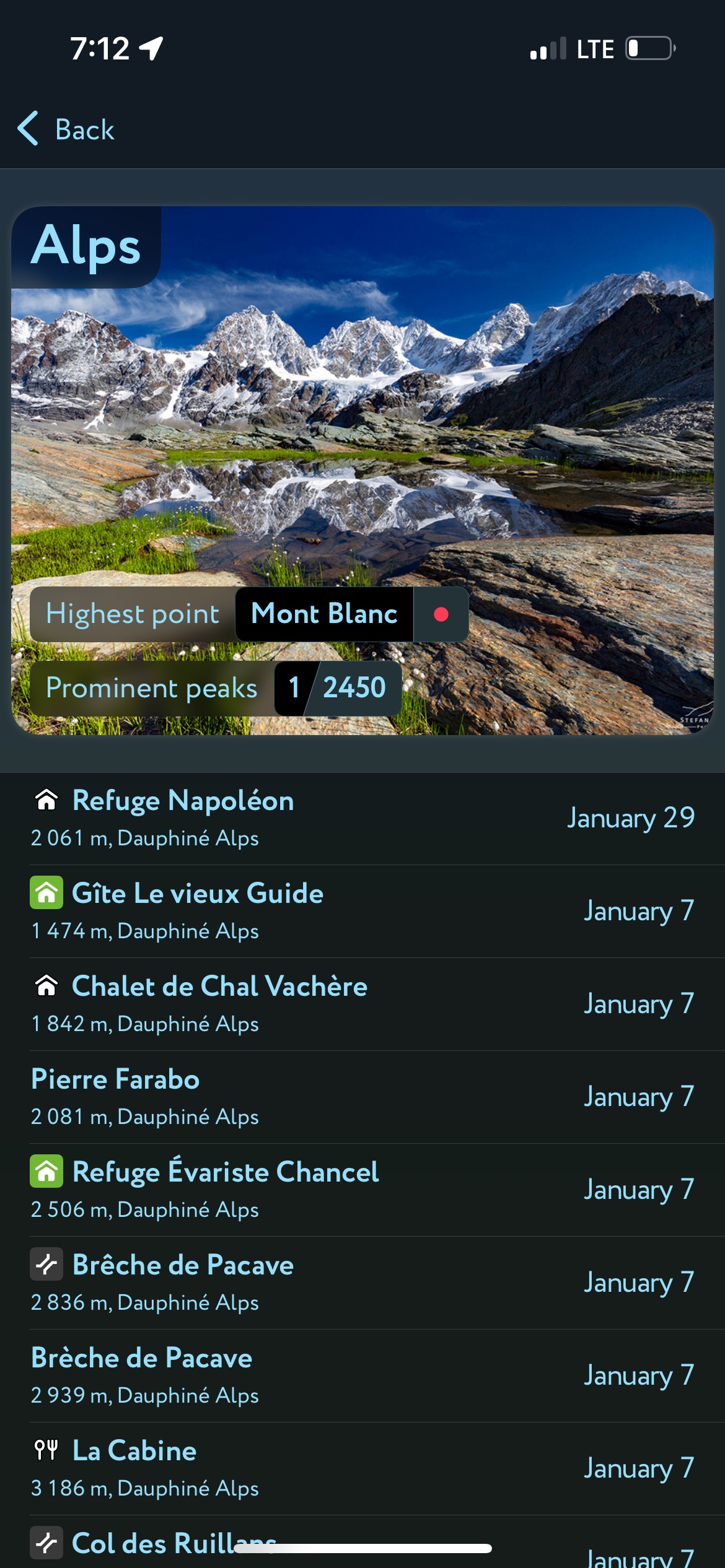Chronicling the Parc National des Écrins' Most Iconic Routes
As time passes, relatively few skiers may recall the warm, dry conditions that have gripped the European Alps during the winter of 2025. Nevertheless, after a February so dry that it necessitated the purchase of a powerful bedroom humidifier, lest one's lips become detached from one's face, March brought blessings to the remote and mighty Écrins Massif.
Alas, the Écrins’ perfect location between the Northern and Southern Alps has afforded us just enough storms; the high altitude and great north faces preserved our ration of snowflakes like pickles in brine; and the high glaciers retained enough of last year’s epic snowpack to have plugged most of the yawning crevasses.
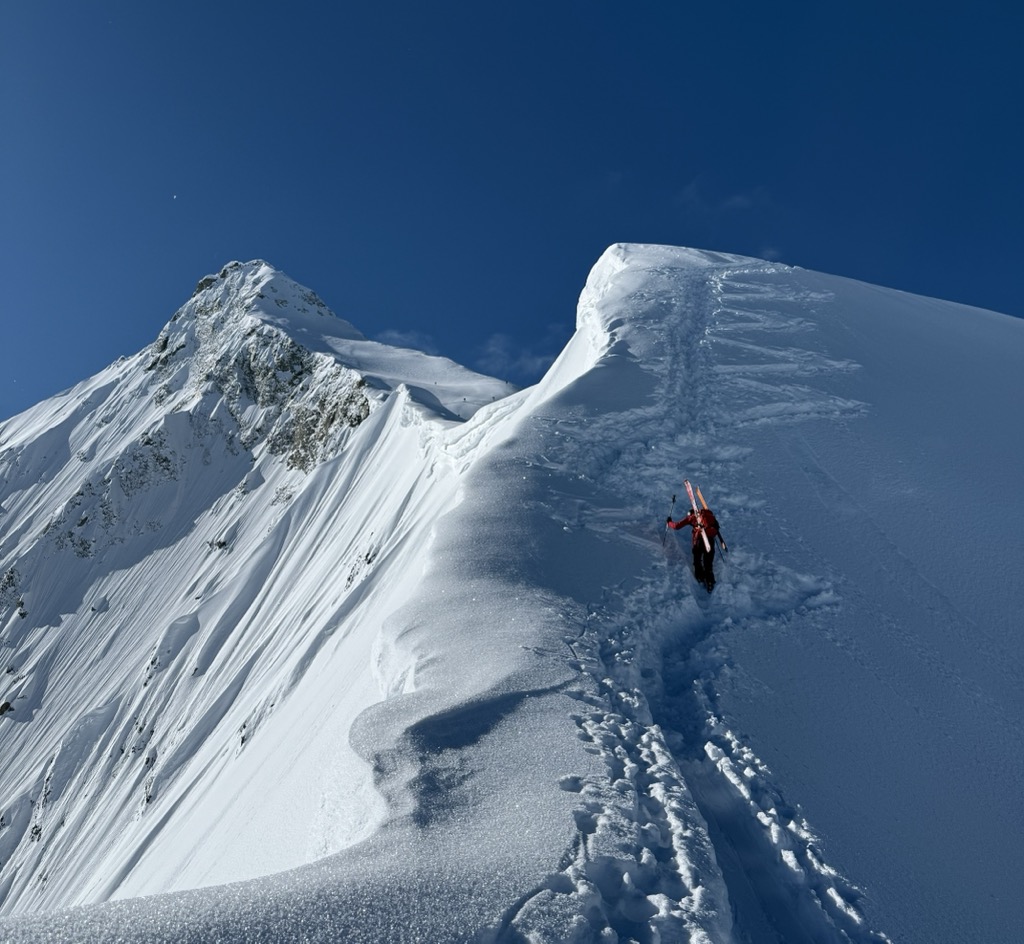
We knew it was once again time to venture into the land of shadow valleys and serrated peaks. The specific planning—connecting the dots between the refuges—was left to one Anna Maude Lochhead-Sperling. Anna’s brain loves processing variables, and we had many parameters to abide by: dream lines, risk tolerances, a short weather window, and a non-negotiable birthday commitment in Le Casset were among the many considerations on the table.
Eventually, we decided on two mega-classics of the Écrins: The Neige Cordier (literally on the cover of the guidebook) and the Couloir Nord de Roche Faurio, cited by many to be among the best coolies in the Écrins. Our first night would be at Refuge L’Aple de Villar d’Arêne and our second at the Refuge des Écrins. Just like that, it was time to set off.
Setting Forth
Getting to the Refuge L’Aple de Villar d’Arêne takes slightly longer than you might expect, given its vertical gain of just 450 meters from Pied du Col, a hameux of the greater metropolis of Villar d’Arêne (pop. 280). We opted for a late afternoon start and arrived huffing, puffing, and sweating magnanimously at the refuge 15 minutes late for dinner.
We followed a veritable highway of frozen skin tracks. Approaching the final stretch, we gained sight of our target. Showing no signs of life, the imposing, austere building resembled a barracks; or, perhaps, an old soviet gulag set amongst the frozen landscape. I had passed by this refuge many times but have never opted to stay, and now I could remember why. For a minute, I wondered if there could be an error, until one of the guardiens scuttled outside to switch on a generator.
As we wrapped around the building to the front side, I could see skis scattered around the entrance to the building. Turns out this was just overflow. Stepping out of my bindings and into the refuge, I entered a foyer containing what appeared to be almost a hundred pairs of skis. Oh boy, it was going to be full tonight! I quickly calculated and realized that there were several times more people here than at all of the other French refuges I’d ever stayed in, combined. How lucky we had been to pass these nights with just a handful of other patrons!
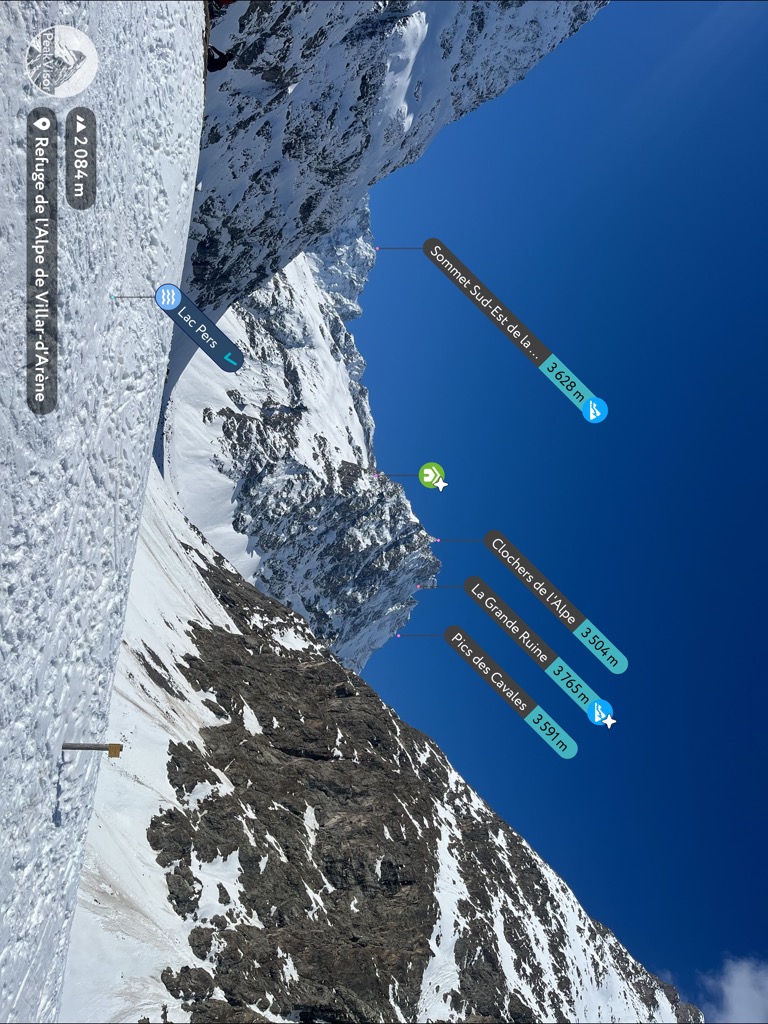
Refuge de L’Alpe de Villar d’Arêne: Worst Refuge in the Écrins?
The din of conversation and laughter drifted from the dining hall as I peeled off my boots. As it turned out, there was a group of a few dozen from the French military. This is a common sight at ski resorts, but I had yet to see such a large group training in the backcountry. To the credit of this refuge, they made no fuss about us being a few minutes late. The food was decent, as one would expect from a French refuge. Being lower in elevation, the Alpe de Villar also offers better amenities than alpine shelters. For example, you don’t have to buy water, a huge blessing.
It’s customary for the guardians to inquire about each party’s itinerary as they pay the bill. When we mentioned the Neige Cordier, the guardians warned us that the east-facing couloir would heat up quickly in the morning sun and advised an early start. They also clued us into the fact that the army would be attempting the same route; they planned on a 4:30 a.m. start time. Our group couldn’t bring itself to start earlier than that, so we agreed on 5 a.m.
I was both relieved and miffed to have the army group ahead of us. On the one hand, it would ensure an established route. In particular, booting up a steep couloir in waist-deep snow is never fun, and I would be lying if I said I wasn’t deeply dreading it. Having such a large group in front of us would be our best hope for an established, fast bootpack. On the other hand, having a conga line of uniformed personnel ahead of you in the Écrins has the potential to take away some of the magic of France’s most remote range. Not to mention the various hazards of dozens of skiers trampling the snowpack above you.
Unfortunately, night brought a familiar plight to those who frequent mountain refuges. It was a sleepless night. I mean a truly white night where I can be certain I achieved exactly 0 seconds of total sleep. Having stayed in a multitude of mountain refuges over the years, it can’t be overstated how uncomfortable this place was. A flimsy piece of cloth served as a sad excuse for a pillow as the length of my 191 cm frame uncoiled into a bunk bed straight out of a Japanese overnight train. I believe there were 16 people crammed into this small dortoir. The temperature, comfortable in the dining room downstairs, now erred on the side of boiling. We opened a window.
Finally, it was time to get downstairs and just get on with it. As a final straw, one of the guardians scolded Anna and me for eating too many pieces of bread. I believe we both had three pieces each. Frankly, it was a relief to rid ourselves of this refuge factory and peel off into icy blackness.
Neige Cordier
Fortunately, there was an established skin track leaving the refuge because, as it turns out, navigating in the dark at 5 a.m. is quite tricky, even when you have a headlamp. A glance at the PeakVisor app confirmed the route, and we began to work our way up the valley as fast as possible to avoid getting broiled in the couloir.
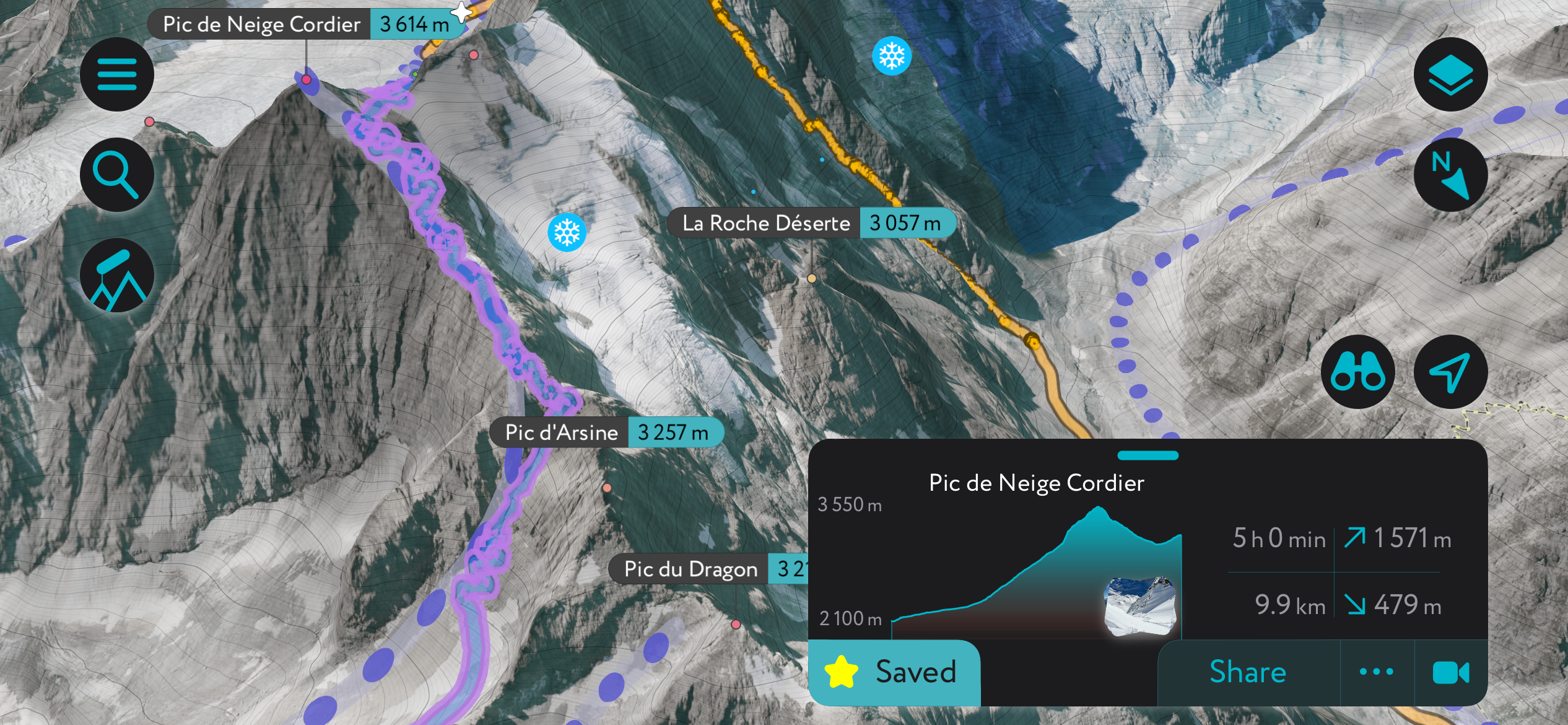
To our surprise, dawn’s first light appeared not long after takeoff. Sunrise wouldn’t be for another hour and a half, but we were now walking into a faint blush that illuminated the surrounding mountainscape and eliminated the need for a headlamp. Up ahead, I could see the soft glow of the army’s headlights steadily working their way up the moraine of the Arsine glacier.
Reaching the moraine, we forked skiers’ right just before the Col d’Arsine. With the Neige Cordier, you don’t see your line until you're right on top of it. Gradually, the aspect trended further and further to the east. The sun began to rise. The touring was fast and easy, and it felt exhilarating to be flying through terrain.
After an hour or so of kicking back and forth, we reached a bowl and could see our couloir splitting the mountain, ascending to the Brèche de la Plate des Agneaux. At this point, we had caught up to the army; it was a bit of a circus with dozens of ski mountaineers transitioning on the steep slope for the boot pack. We suited up into crampons, but the snow was still soft and deep, and there was no need for an ice axe.
In the lead up to this tour, I’d built up a nightmare scenario in my mind of bootpacking up a warming couloir in waist deep snow with rocks tumbling all around; all based on the horror stories of past parties. None of it materialised. The bootpack was established, thanks to our military brethren, and it took about 20 minutes to get through the 200-meter gash in the mountain. In fact, the couloir still had winter snow, meaning it hadn’t transformed in the blazing sunshine of the previous few days. While I still think starting early is essential, the couloir’s elevation—between 3000 and 3200 meters—seems to keep the most extreme warming at bay, even during a relatively warm spell in late March.
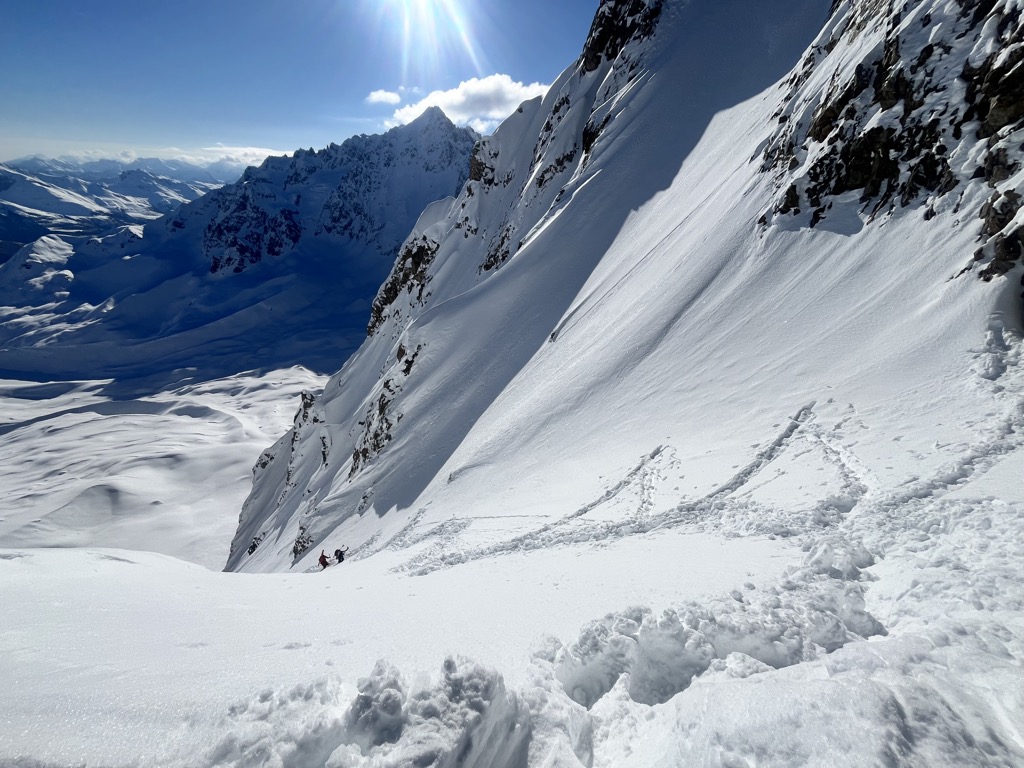
Once again, I felt exhilarated, though my climbing speed was mainly attributable to the beautifully set bootpack that lay before me. Climbing out of the couloir onto the strip of snow that gives the Neige Cordier its name, I knew why this was a classic. The views and exposure were impressive, with sheer cliff faces on both sides, intersected by a thin strip of snow leading nearly to the summit. The Glacier des Agneaux came into view, a heavenly white interspersed with sapphire blue glacier ice. On this thin precipice, the snow quality remained incredible from the last storm; a thin layer of hoar frost sparkled like millions of diamonds as the sun rose over the ridge to greet us.
Unfortunately, upon arriving at the top of the Brèche de la Plate des Agneaux, we were bottlenecked by the military before us, giving the Neige Cordier the feel of Mont Blanc or Everest during high season. It was a rather bizarre situation for the Écrins, which are remote and relatively quiet.
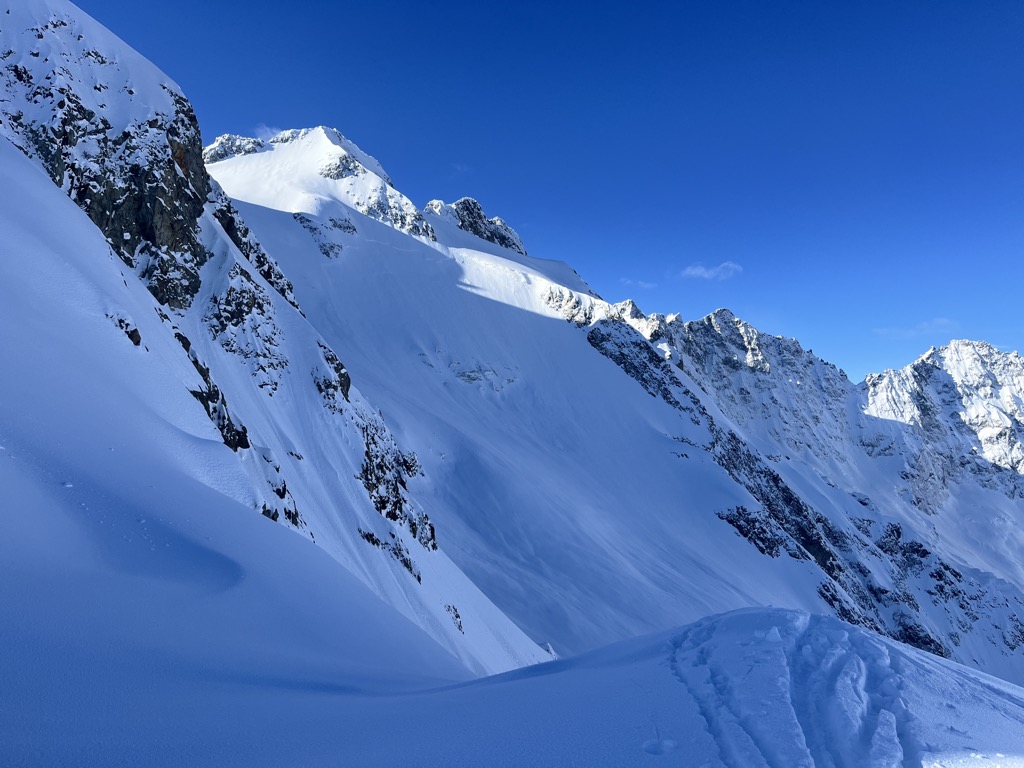
Considering its perch high in the mountains, the route is extraordinarily straightforward. Save for a tiny section of bootpacking, without crampons and just shouldering my skis, it is truly the most aesthetic skin track you can imagine. We zigged and zagged up the face, each kick turn offering a chance to peer down the cliffs onto the glaciers below.
Few ski mountaineers ski back down the way they came on this tour. The majority ski down the Glacier des Agneaux, an Écrins classic. Meanwhile, a minority continue down the Col Emile Pic, onto the Refuge des Écrins.
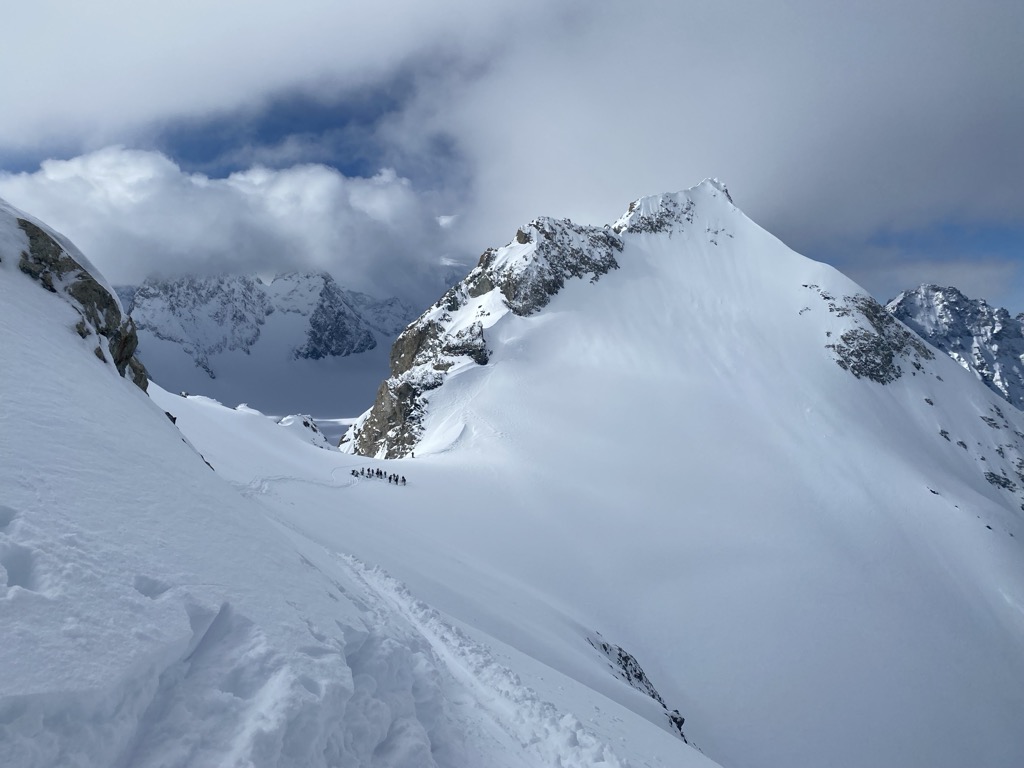
Col Emile Pic
We slid down a shallow slope from the Neige Cordier to the Col Emile Pic. The army peeled off and dropped into the Glacier des Agneaux, while our party headed for the obvious saddle. I peered over the steep convex rollover but couldn’t see over, and appeared to be on the verge of tickling a wind slab.
The Col Emile Pic is definitely the technical crux of this magical shortcut to the Refuge des Écrins. It requires a rappel, preferably with a 60-meter rope, for the most straightforward footing to get your skis back on. There wasn’t much information on this beast, so we didn’t know much before heading in, except that a 60 would easily suffice.
I decided to use a rope to head down. It’s a steep climb to get to the anchors, and a fall would be catastrophic. Just as I was about to slip down to the anchors, which I still could not see, a head popped over the horizon. It was a party of four heading up over the Col for the Glacier des Agneaux. Frustratingly, this required us to wait 30 minutes for all four of their party to navigate out safely, but it mitigated my concerns for a wind slab. It was a day of traffic jams.
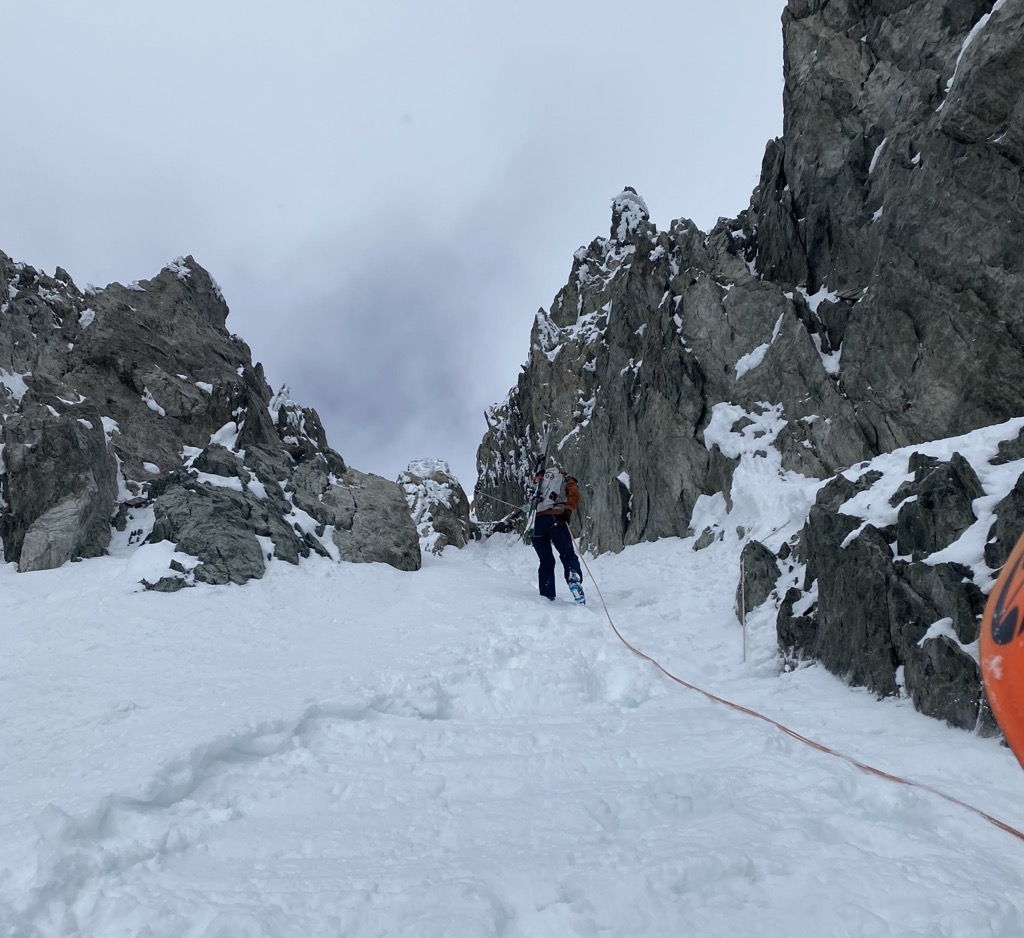
I skied down to the rappel, which turned out to be the wrong move; the line funnels into a choke in a way that doesn’t allow you to rappel with skis. Taking them off at the anchor was a mega pain, and I nearly dropped one of my skis, which could have necessitated a helicopter rescue.
For the Col Emile Pic, each member of the party must take care stepping down to the anchor, which requires an additional transition at the top into crampons and ice axe and back into skis on a steep slope at the bottom. It’s not overly difficult, but it takes time, and it's darn cold at 3,400 meters.
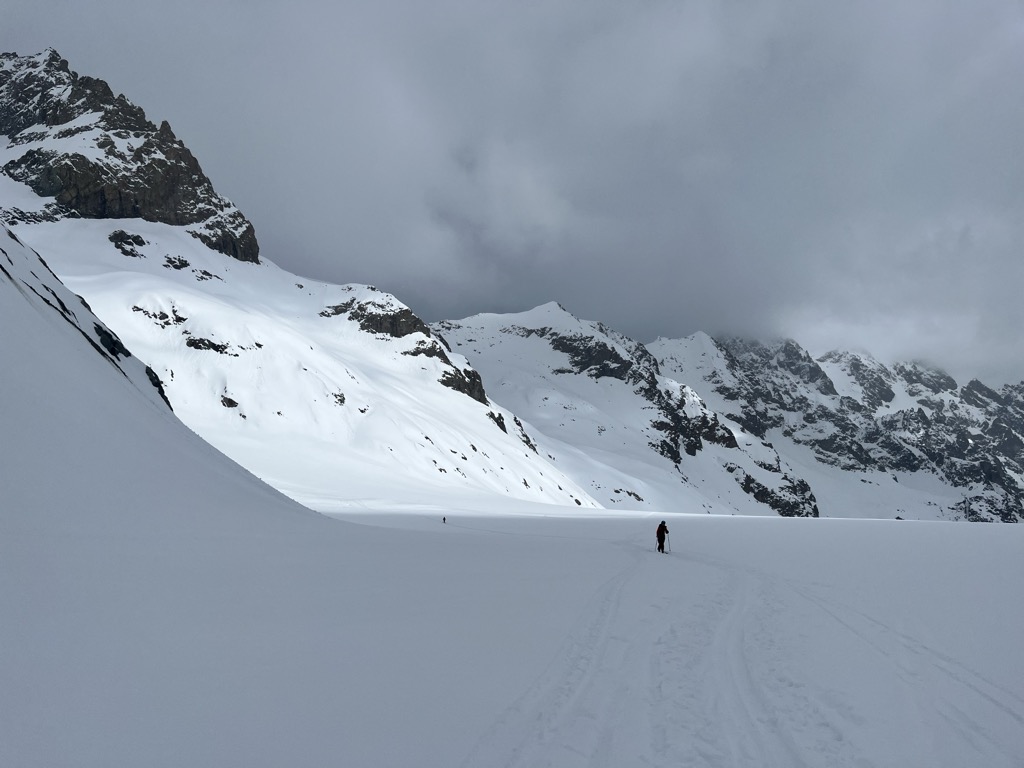
After the col, we readied for what should have been an incredible ski descent down to the Glacier Blanc. Unfortunately, between waiting for the col to empty out, transitioning, and rappelling, hours had passed. A high cloud settled itself in front of the sun, and our southeast-facing slope refrosted into something fierce. There was a bout a 2 cm sun-crust on top of powder. At times, the crust was almost so thick that you didn’t break through…but then you would always break through. I’m telling you folks, it was among the most unskiable snow I’ve ever witnessed.
Ski turns were utterly out of the question; I made kick turns down the entire face. After all the effort we’d put into the day, it was dispiriting to be unable to enjoy this small slice of ski pleasure. Moreover, we now found ourselves transitioning yet again, this time to climb the 100 meters from the glacier to the Refuge des Écrins. It was so close, yet so far away. The south-facing slope was broiling in the midday sun as we ascended like snails crossing a patch of desert. Wishing I could de-layer right down to my birthday suit, I overcame a moment of self-pity and made the final push. The chill of Col Emile Pic seemed an eternity away; this face might as well have been a dune in the Sahara.
At last, 8.5 hours after setting off, our weary bodies reached the refuge.
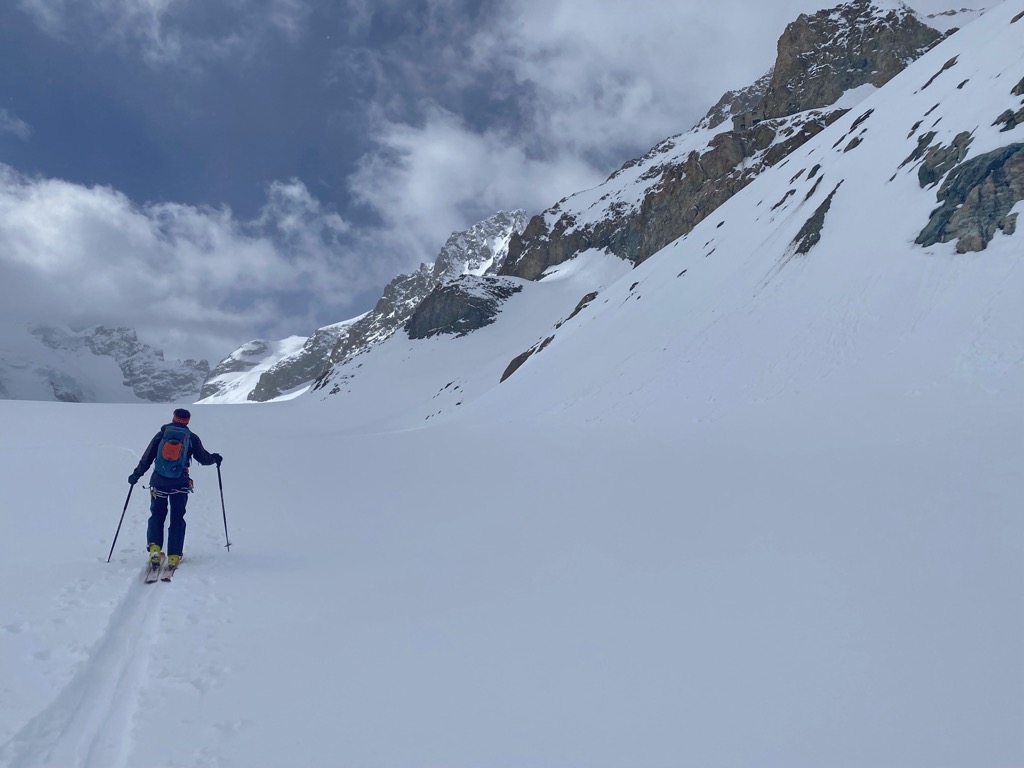
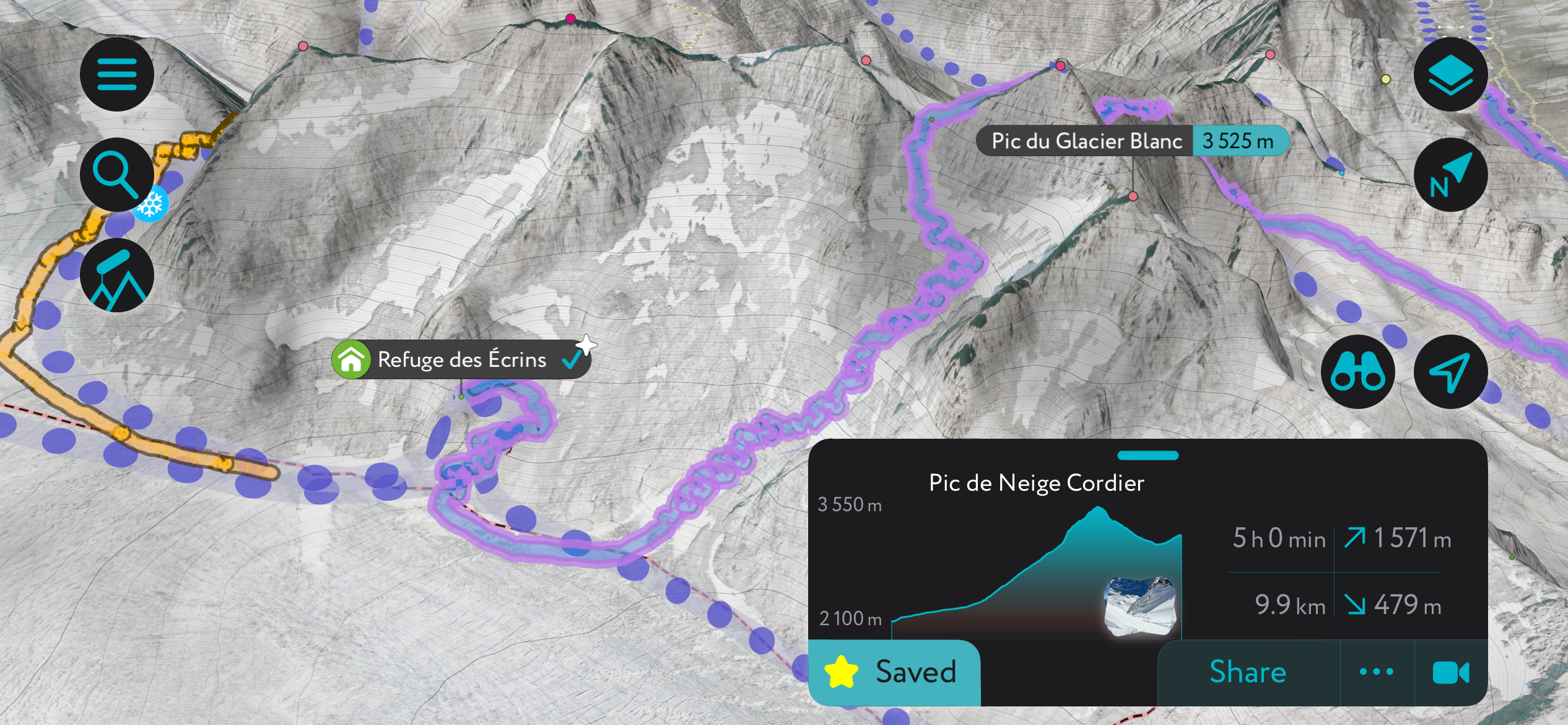
Refuge des Écrins
In contrast to the servants' quarters known as Refuge d’Alpe de Villar d’Arêne, the Refuge des Écrins was a palace, a portal to tranquility, relaxation, and dehumidification. As I basked in the afternoon sunlight that drenched the spacious dining room, I could feel—and smell—the sweat evaporate from my body and clothes.
I promptly purchased several liters of water and began the long journey to rehydration. After eating almost nothing for the duration of the tour, it was time to devour at least one of the three sandwiches I had lugged up the mountain. The three of us sat silent, consumed by our hunger and exhaustion.
After a while, consciousness itself became too heavy a task and Anna and I settled into our dortoir, which was of exceptional comfort, and promptly fell asleep for three hours.
Upon regaining consciousness, I felt like a new man. The dreamless stupor that I had succumbed to for the last three hours had powerwashed the adenosine from my brain. I felt relaxed but alert. My attention shifted to the window, where the afternoon light still filtered in with some intensity. There was a direct line of sight to the Barre des Écrins (4,102 m / 13,458 ft), its glacier-encrusted north face dazzling in the sun’s radiance. A main uphill skin track and several ski descent tracks were visible snaking through the seracs and crevasses. It’s a view that commands your attention.
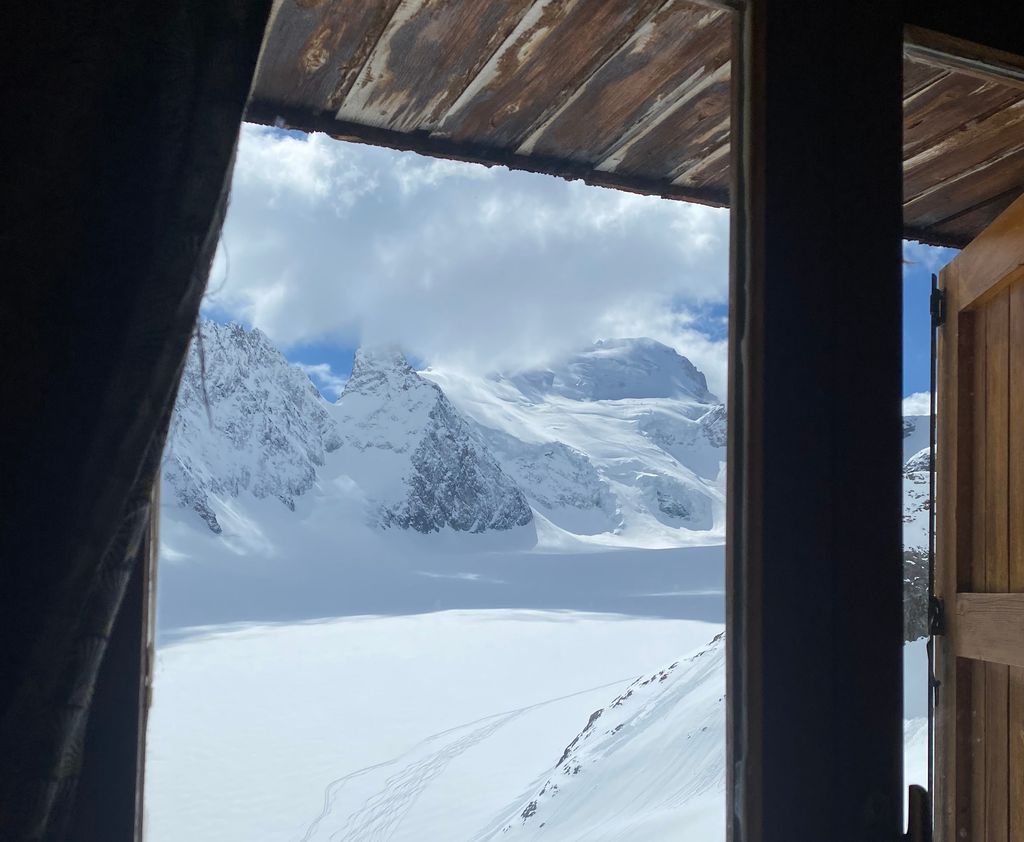
Venturing downstairs, we discussed the next day’s descent. We had our sights on either the Roche Fario couloir (5.3, 55°) or the Dôme de Neige (the main non-technical subpeak of the Barre des Écrins). The Dôme is a 4,000-meter classic, but the true prize here at the Refuge des Écrins is the Roche Fario. It’s one of the finest couloirs in the Écrins, if not the Alps. As we sat in the fading light, eagerly awaiting dinner, the Roche Faurio just felt right. It’s an Écrins dream line that relatively few people have done because it basically requires at least two days in the mountains.
As I mentioned, the guardians will generally inquire about your planned itinerary. In this case, even the guardian had never skied the Roche Faurio and did not know the current conditions. In fact, he tried to dissuade us, offering a number of other itineraries that would bring us to Le Casset the next day.
At last, dinner was served. It was an intimate group, with just 11 fellow mountaineers, and the meal was unmarred by economies of scale like the more crowded refuges. We’re talking split pea soup, followed by mushroom crozet—a pasta from the Savoie region—with beef bourguignon, followed by a cheese plate of tomme, and concluded with a gateau de citrôn. Moreover, our cherished guardian offered us as much as we wanted, even bringing out a third helping of beef. None of us could have asked for a more delicious meal, and I really think it went a long way in helping our performance the next day.
During dinner, we discovered that out of the other three groups, a group of three and a solo man also wanted to do the Roche Faurio, while the final group of four would attempt the Dôme.
Now, I’d be lying if I said there wasn’t competition in the air. When we confirmed our breakfast time of 6:30 with the guardian, this group quietly changed their time to 6:30 as well.
After my experience the previous night and the exhaustion of the day’s climb, my sleep at the Refuge des Écrins was the holy sleep of the mountains. Though we were all in one dortoir, only fit people can make it to this refuge; therefore, nobody had sleep apnea, or some other form of obstructed airway that you’ll find at the easy-access refuges. Wide-open bronchial passages only.
I awoke only once to empty my bladder. Stepping outside in a stupor, gazing upon the dancing stars above the gently illuminated Barre…that’s why we venture into the mountains. Roche Faurio or no Roche Faurio, skiing or no skiing, the day’s trial and tribulations were worth it for that view.
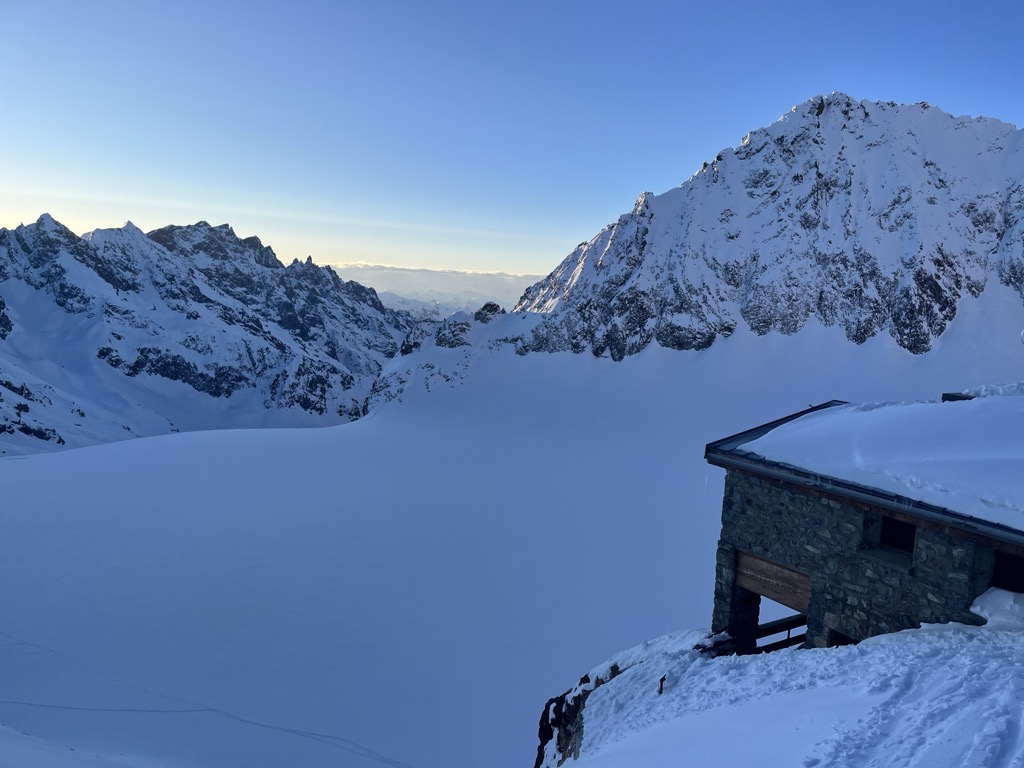
Couloir Nord Roche Faurio
We arose and made it to breakfast at 6:30, bags packed and ready to go. It was now fully evident that everybody was hustling to get to the couloir first. The transcendental enlightenment during my midnight toilet trip was apparently fleeting, because getting first tracks now seemed like the only thing that mattered.
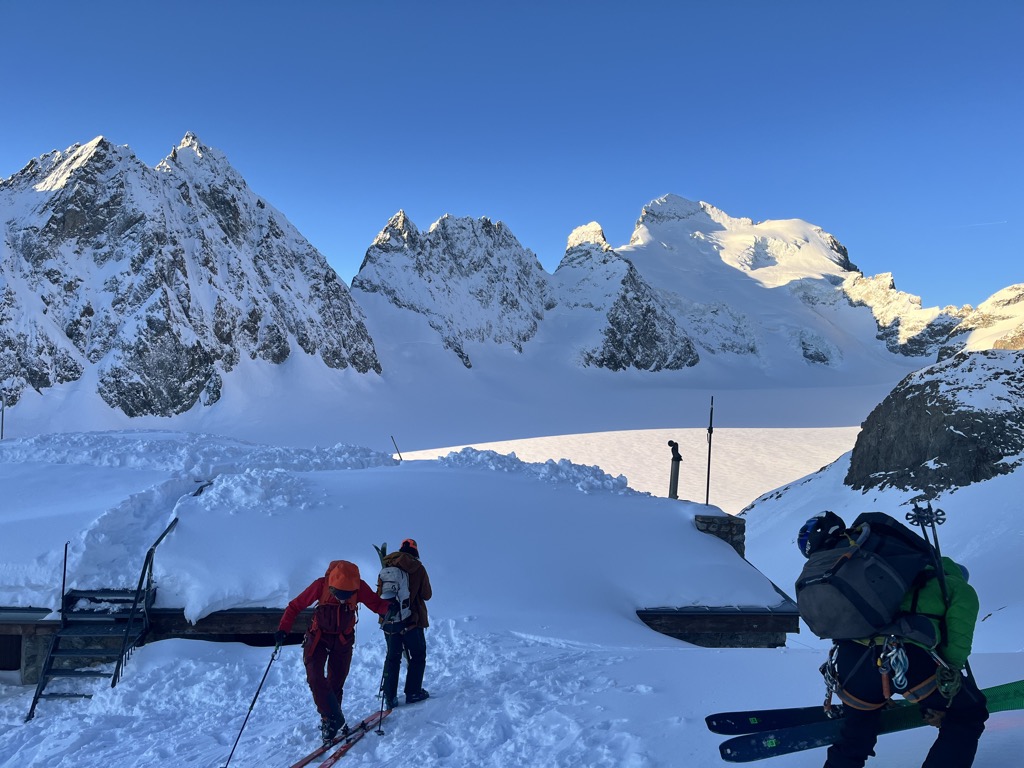
We skied the icy face down from the refuge, tossed on our skins, and I practically started running up the Glacier Blanc. I was in the lead! I came up around a slight bend, heading to the next bowl on the right side of the glacier. Our solo friend had bested all of us! He was halfway up the bowl already and moving fast.
It’s a short skin from the refuge to the col that forms the couloir's entrance, so I arrived a few minutes after him, with the rest of my crew and the other crew trickling in one by one.
Here’s the twist. This thing was formidable, and each and every one of us was humbled. Just like that, our priorities were re-aligned, and though we may have been racing each other, we all realized that teamwork was going to be important.
The Roche Faurio is a 5.3 ski descent—there aren’t many descents with a rating this extreme—but, unlike other 5.3 descents, the crux is easily navigable with a rappel.
We knew that the upper section had been mainly rock until just a couple of weeks prior. Not anymore! It was wide and white, gently fluted, and looking sublime. However, with close to a meter of new snow at the top of the couloir as well as a large cornice, we decided to rap in. We had nothing to prove to the world, but other parties may opt for the challenge of skiing off the very top. It’s very doable if there’s enough snow, but you’ll have to contend with a lot of slough if there’s been a fresh fall, and losing your footing in the section would probably be fatal. So there you have it. You can sling any number of rock horns to the skier's left for the anchor.
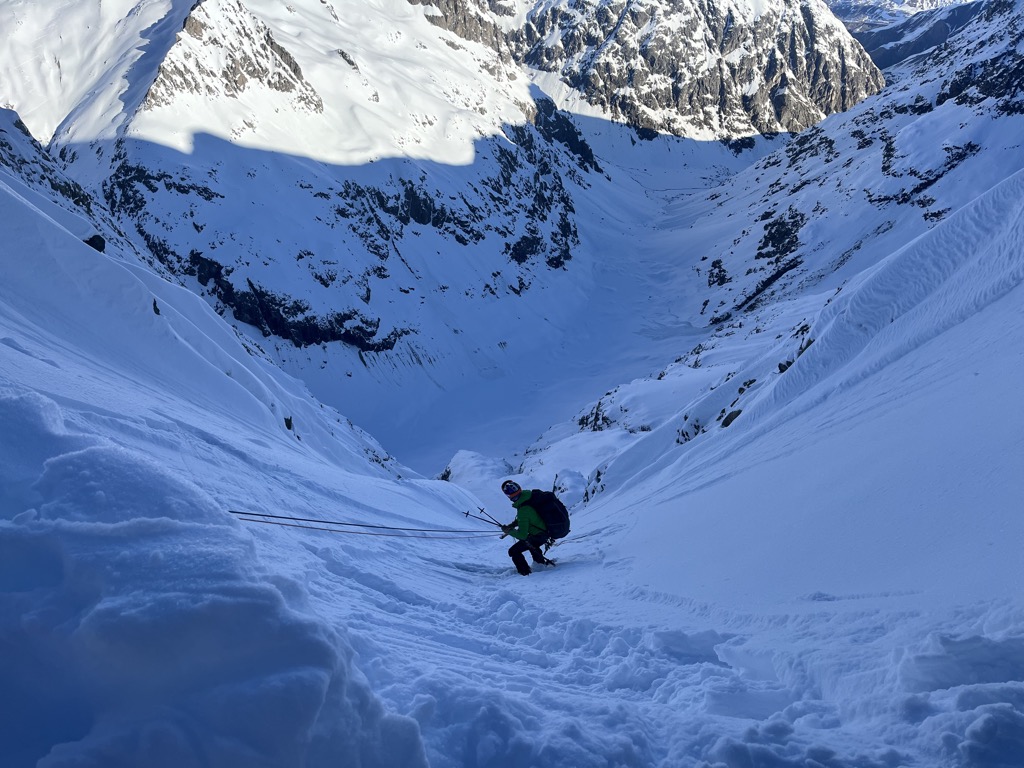
About 60 meters down, the fun begins. We’re talking slope steepness somewhere in the high 40s; just enough to link powder jump turns. The snow conditions were excellent; dense, consolidated powder that hadn’t seen much sun and only gentle wind. You weren’t skiing alone; a little river of your own slough would always be dancing around in the vicinity, but not enough for real concern.
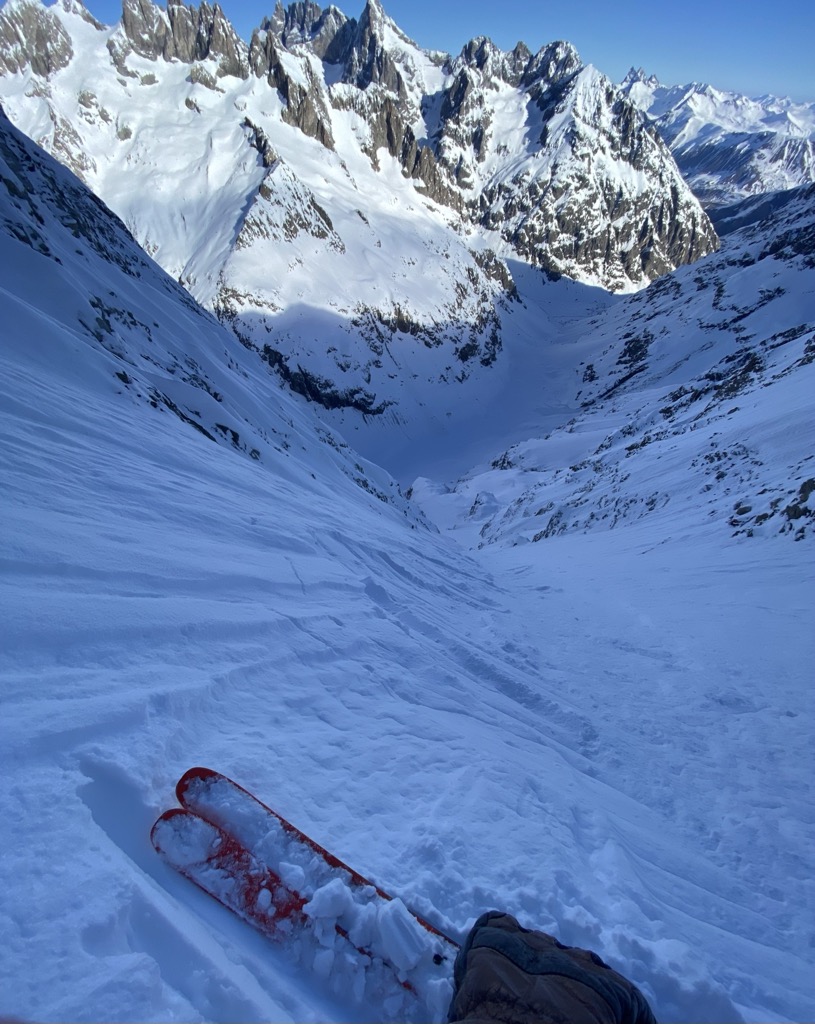
After about 200 meters of steep and narrow, the couloir opens into a broad hanging face, before pinching back down again. These were the best turns of the day, with excellent powder conditions and a perfect 45° slope. The wind had arranged the snow into soft, playful rivulets and spines. By this point, the seven of us were simul-skiing, giving ample distance between each person. As each of us reached the bottom, high fives and exclaimations of friendship were exchanged. Ultimately, it was like a fable for skiing in the modern age. Forgo the frothy competition. It was way more fun skiing as a team, all looking out for each other, than it would have been if we’d been first.
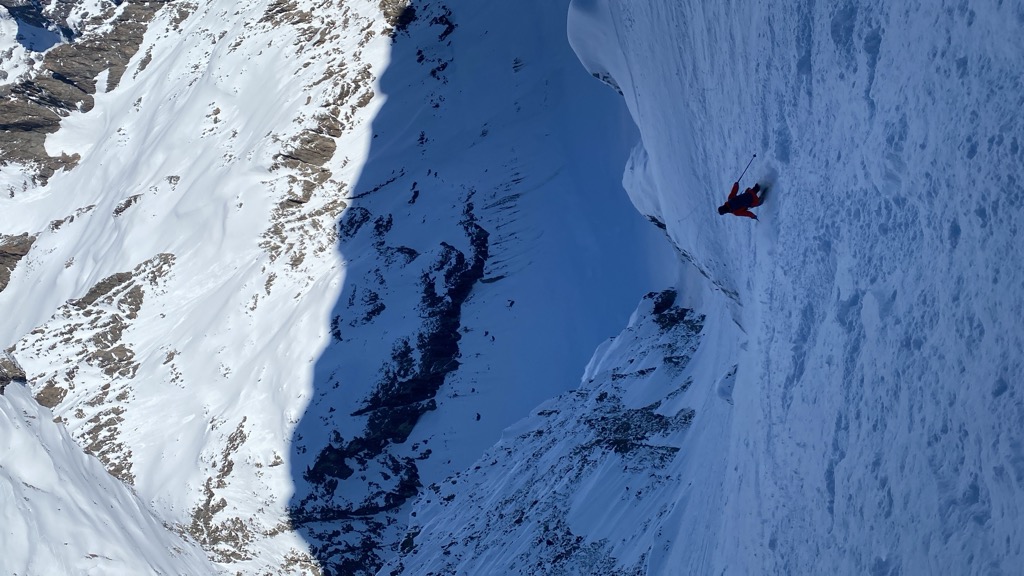
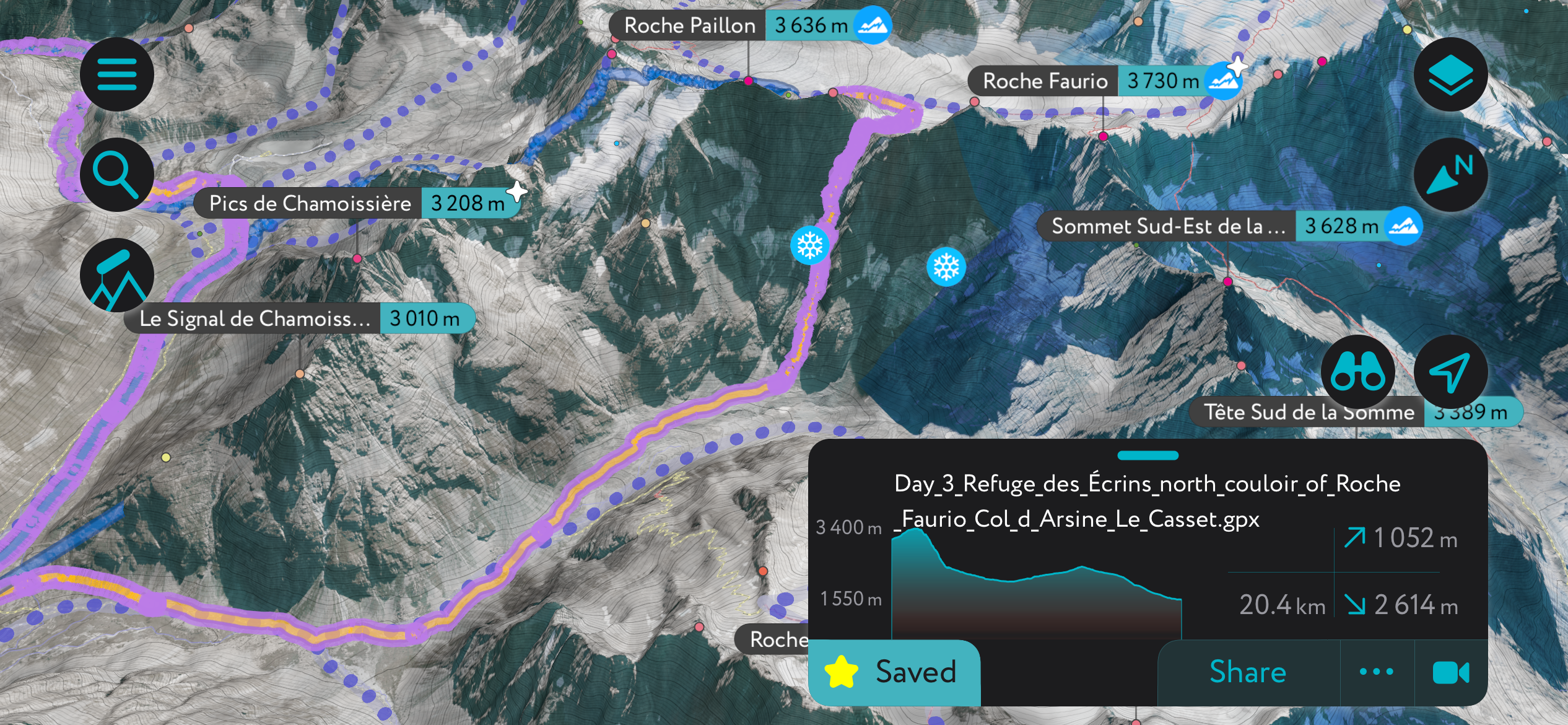
Col d’Arsine and Le Casset
We hit the bottom of the Roche Faurio at a punctual 9:30 a.m., three hours after setting out from the refuge. Our new friends were heading to the refuge Adèle Planchard, while we were heading out of the mountains to the village of Le Casset. We skied as far as we could, poling over flat sections. This takes you just shy of the Refuge Alpe de Villar d’Arêne, where we’d stayed the first night. Then it’s about 300 meters of climbing to the Col d’Arsine, and down the valley into Le Casset.
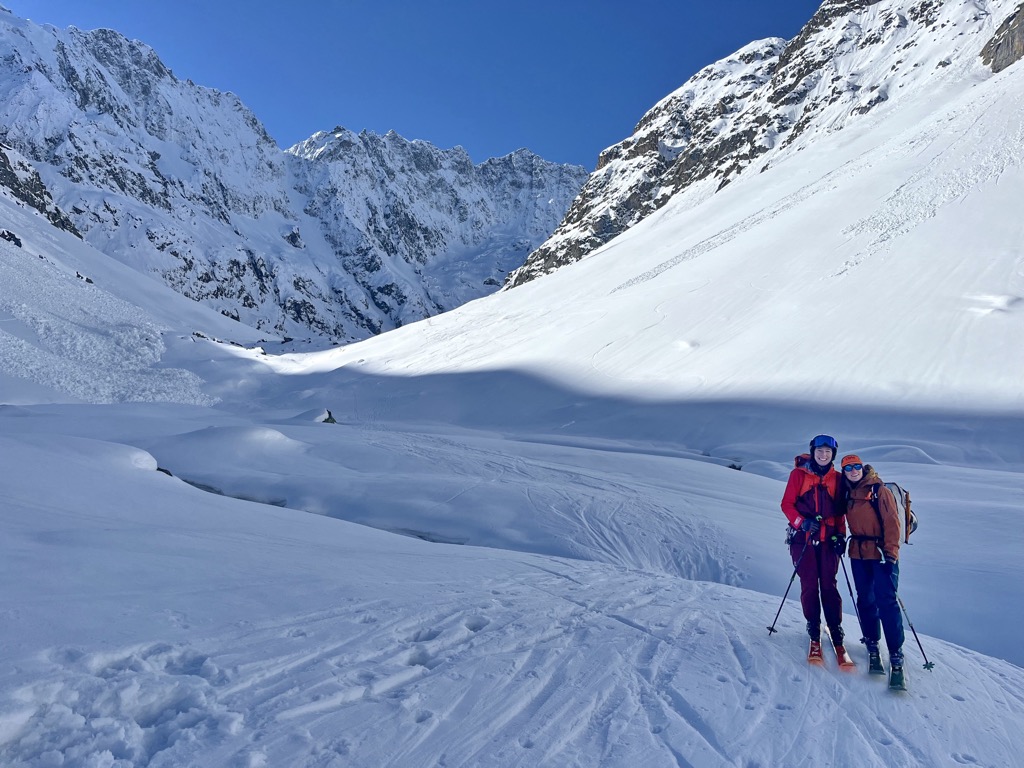
Not much to report here. It was pretty straightforward. One thing to note is that it’s necessary to traverse along south-facing slopes to get to the Lac de la Douche. These slopes were boiling in the midday sun by the time we got there at noon, and you’re quite exposed to the slopes above. The hot snow was sticky and slow. Large debris piles littered the valley, though they had released ages ago, probably during or right after the storm. It's not a huge deal, but it's something to note.
After that, it’s a quick zip down a multiuse trail from the Lac de la Douche to Le Casset. We had snow almost the entire way, a massive advantage for three tired skiers. In the end, we even showed up early for birthday lunch at Chez Finette, all in one piece.
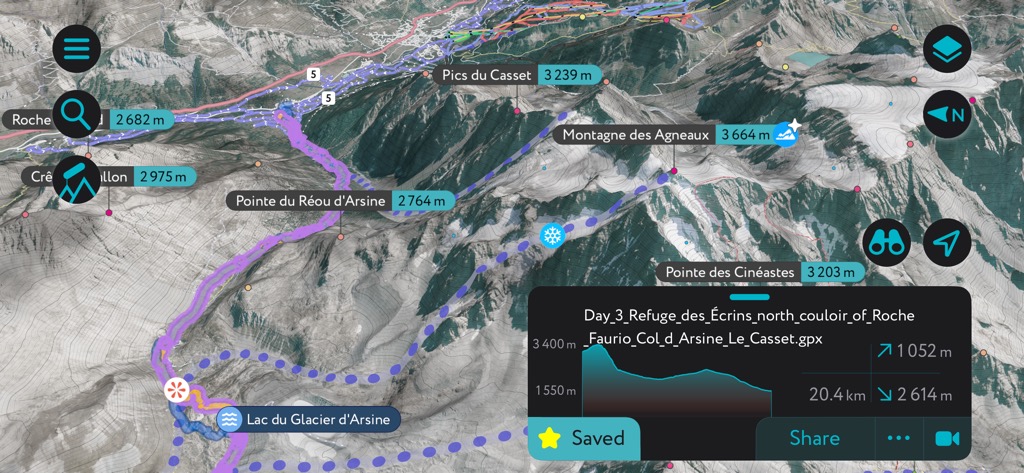
Using the PeakVisor App
Interested in skiing? Check out the PeakVisor App. PeakVisor has been a leader in the augmented reality 3D mapping space for the better part of a decade. We’re the product of nearly a decade of effort from a small software studio smack dab in the middle of the Alps. Our detailed 3D maps are the perfect tool for hiking, biking, alpinism, and, most notably in the context of this article, skiing!
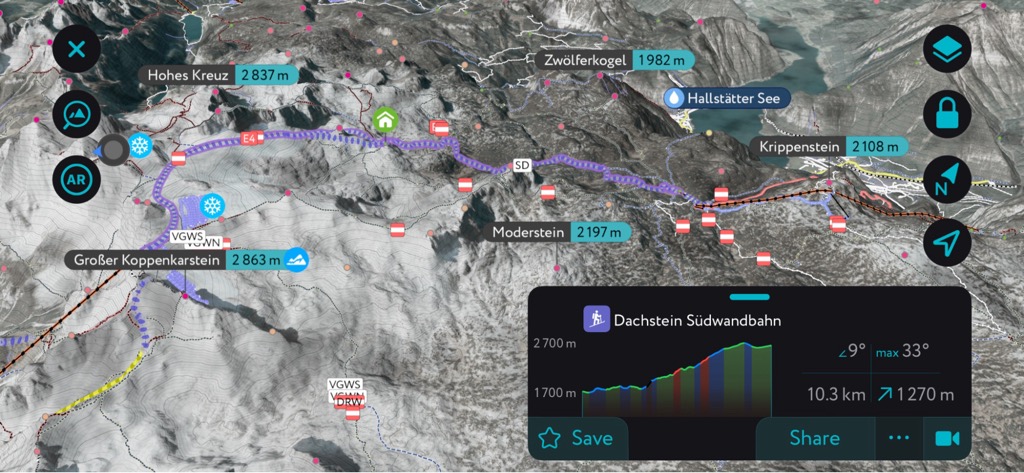
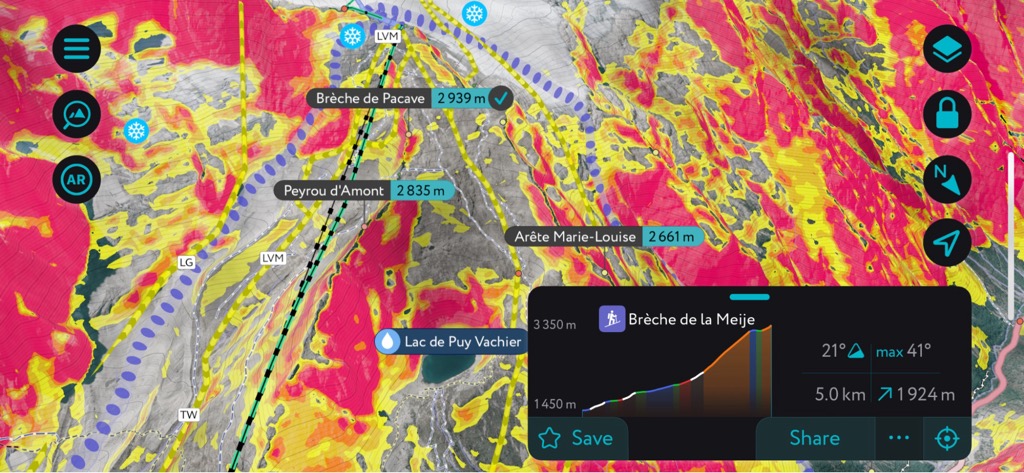
PeakVisor Features
In addition to the visually stunning maps, PeakVisor's advantage is its variety of tools for the backcountry:
- Thousands of ski touring routes throughout North America and Europe.
- Slope angles to help evaluate avalanche terrain.
- Mountain hut schedules and contact info save the time and hassle of digging them up separately.
- The route finder feature generates a route for any location on the map. You can tap on the route to view it in more detail, including max and average slope angle, length, and elevation gain.
- Up-to-date snow depth readings from weather stations around the world.
- A point weather forecast for any tap-able location on the map, tailored to the exact GPS location to account for local variations in elevation, aspect, etc., that are standard in the mountains.
- You can use our Ski Touring Map on your desktop to create GPX files for routes to follow later in the app.
